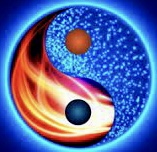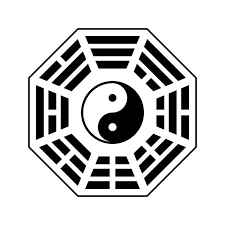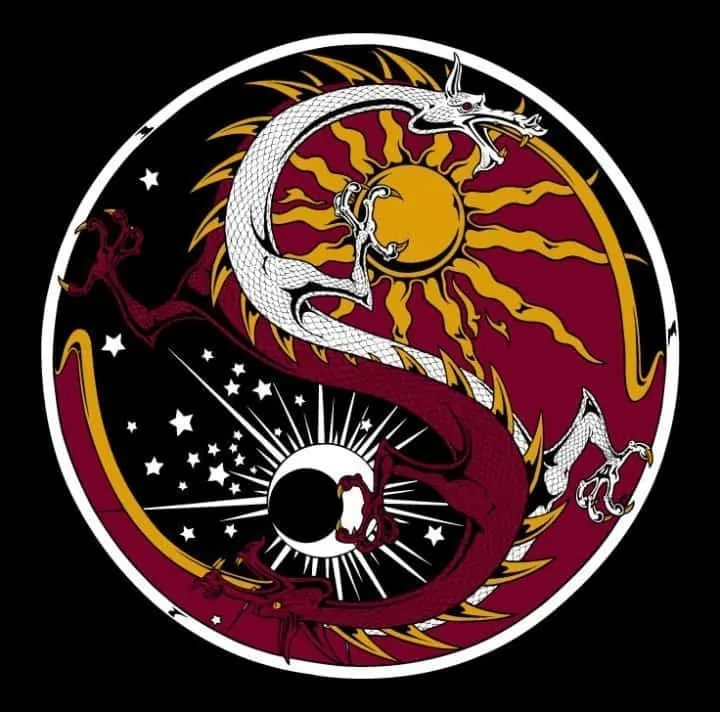The Yin and Yang of It All.
- Lea Williamson, ShiFu
- Feb 21, 2023
- 7 min read
Updated: Feb 21, 2023
How I’ve come to understand the basics of the “yin yang” symbol.

”You’d think as a tai chi teacher, I would have thought a little more about the black-and-white symbol that represents tai chi and the philosophy of the Dao. I knew it represented the yang and the yang, and that there‘s a little yin in yang and vice versa, represented by the two dots near the middle of the circle. I knew it was called a taiji not ”a yin-yang,” as most people called it. I knew the black yin part represents stillness, or beingness. And the white yang part was the doingness of activity. . . . I was compelled to learn more.
“In the taiji symbol, black is yin and white is yang. The symbol can be viewed in terms of a 24 hour day. A day is one thing that’s divided into two: night and day. An entire day moves through both night and daytime, so both parts are necessary for the whole. Since blackness happens at night, yin can be associated with nighttime and the energies of that time of day. White yang represents the daytime and the energies associated with that time. . .
”In the night, energies are naturally slower, more even and still, when we are sleeping. Most creatures of the natural world rest in the night, but not all; just as some are more active in the day, but not all. The moon, mostly visible at night, is considered yin, while the sun is considered yang. This makes sense within the balance of activity and inactivity. . . .

”I learned that, in a traditional perspective, water is considered yin and fire is considered yang. Therefore, in antiquity, and sometimes even today, the taji symbol was not black and white, but blue and red, referred to as Kan and Li. …
”This night-and-day metaphor of the taiji also holds true within the idea that one becomes the other. Within the symbol, black tapers off into white and vice versa, allowing its companion to become fully itself. Night gradually becomes day, and day gradually becomes night. Night does not become day all at once. It’s a gradual shift until day is completely day with no moon or stars to be seen. So, it is not a straight-line, linear shift. This is seen in the center curve of the taiji; there is not a straight line between yin and yang, but a curving center line that continues turning when viewed with the symbol spinning. This is the ever-changing, ongoing cycle of do be do be do that is the nature of our world. Doing in the day, being in the night. Each needing the other to simply exist; not opposing but supporting each other.” — Surfing the Sea of Chi, Lea Williamson
When I first wrote these words in 2016, I really didn’t know all that much about yin and yang and what the Taiji represents. I’m grateful that my understanding has grown and I’ve when I view my life in terms of yin and yang and conduct myself to balance these two, my obstacles are easily bypassed. It’s not possible to reduce yin and yang and our perceptions of the world into black and white. They go much deeper than that, with subtle nuances. Consider all the nuance of meaning that the words “soft” and “hard” can have. My muscles can be hard-yang or soft-yin, both are necessary at different times. If I don’t know how to make them hard and do some work, things could be more difficult. If I don’t know how to relax them and make them soft, things are most definitely more difficult as tension sets in quickly followed by fatigue.
When I teach yin and yang as it pertains to our health and bodies, I make it simple because when it’s simple, it’s easy to understand. Then the same simple idea can be used in other, more complex relationships in our lives that go beyond the physical body. So, while it’s impossible to reduce it to ”black” and ”white,” the following could help understand how to use taiji philosophy in your own life.
Yin Yang
Feet Hands
Legs Arms
Bottom Top
Left Right
Front Back
Inside Outside
Light Heavy
Empty Full
Energy Material
Wave Particle
Slow Fast
Apathy Passion
Comfort Pain
Cold Hot
Female Male
Mystery Obvious
Rest Act
Flexibility Strength
Short Tall
Small Big
Moon Sun
Meditation Action
This list could go on for pages. At the bottom of this article are a few yin/yang lists I found on a quick Google search. Once I started viewing my work, my relationships, my body, my health, my world and life from the yin-balances-yang perspective, everything EVERYthing in my life made more sense on how to deal with it and how to bring it into balance. When I find I’m doing too much work, I play more. When I find I’m getting fat and lazy, I do something fun and calorie-burning every day. When I find myself enjoying too much rich food, I fast or eat simpler and at home. When I’m bored with food, I spice it up or go out somewhere new. When I’m working outside and getting too hot, I get cool before it becomes too much. When I am not making enough money, I focus more on generating income. When I notice getting tired, stressed or hurting more, I focus more on myself and self-care. You get the picture. It’s not rocket science but it does require doing or not doing something to create the balance.
I’ve learned now that this taijitu, as it’s formally called, was intended to be seen spinning, not static. Some dojos may have displayed it on a spindle sticking out from the wall at the door before entering the training area. On the spindle, it could be spun and more of it’s meaning unwound. The spinning symbolizes that yin and yang are always changing in our world and lives. When everything’s falling apart, take heart! Things will change and get better! But don’t get complacent because when things are going well, some challenging situation always presents itself. This is how life works and to expect things to always be smooth and easy is like expecting the ocean’s tide to never recede. If that were indeed to happen, the world itself and humanity’s life on it as a living planet would stop. In the balance of things we learn to expect that sometimes life seems fair and sometimes it seems unfair and that’s just the way of it, not necessarily because we somehow failed. Sometimes life is hard and sometimes it is easy.
Sometimes the taijitu is shown with two outer circles. This is to symbolize our ”embrionic” nature. The white space created between the two circles is to represent the womb and the fluid surrouding our bodies there. This powerful version of the taijitu reminds us not to take ourselves too seriously. That none of us really knows what we’re doing here. We’re all just “winging it” in this life, doing the best we can with what we have, so to speak. And if we think we know how things are ”supposed to be,” or ”what’s best,” reality sometimes changes and lets us know it’s time to broaden our perspective a little, become for flexible. Personally, I like this version of the traditional symbol because it reminds me to play and enjoy my time here, to become ”child like” in wonder and joy so my ”heart does not become hardened” or jaded.

It took me many years to learn this simple symbol that I’ve seen my whole life can be used as a key to a balanced life, whether we use it to understand the strength in softness that is the physical exercise of tai chi or we use it to create a better diet. Either way we can live better because of turning a bit of thought to it. There’s a reason this IS the oldest known symbol on the planet that’s still actively used and recognized. Entire books have been written about the philosophy of this symbol. I explored just the little bit I could wrap my brain around at the time when I wrote the above quote from Surfing the Sea of Chi. But now that it’s in your head, you can probably think of many more ways to benefit from harmonizing your yin and yang. After all, as long as we live on this planet, the high tide (yang) will be followed by the low tide (yin); the inhale (yang) will be followed by the exhale (yin); the north pole (yang) of a magnet will always need a south pole (yin) to be magnetic- some say it’s that difference that literally makes the Earth turn. Maybe, like me, some thought about yin and yang will bring you better natural balance in how you conduct your life, whether you choose to practice tai chi with us and ingrain that balance into your muscles and bones or just notice if it applies to your life in some way.
If you’d like to adventure more into my initial discoveries about yin and yang and how they helped me overcome my fear of water and learn to surf: Surfing the Sea of Chi is an Amazon #1 New Release and journeys with me as I learn to surf at 40 years old using taiji philosophy and qigong breathing to stand up and hang ten! It’s available through Amazon, Barnes & Noble, and in Brevard County at: Another Ride Surf Shop, Patrick Paperbacks, Sebastian Inlet Surf and Sport and to borrow through the Brevard County Library system.
All can see beauty as beauty only because there is ugliness.
All can know good as good only because there is evil.
Therefore, having and not having arise together.
Difficult and easy complement each other.
High and low rest upon each other. — Tao Te Ching, Lao Tzu




Pssst. . . Did you notice my book cover is fire and water, reds and blues, a stable stance on a moving wave? It turned out to be a pretty good cover. I staged and photographed it myself, running back and forth to the camera to reset the timer then run back and try to get in position on the board before the low tide carried it away! Many thanks to those who left a little review on Amazon. (I need 50 reviews for the Amazon algorithm to start showing my book to prospective buyers . . . Still a few more to go at this writing.)
In case you missed it, here’s an oldie but a goodie: my first podcast interview about Surfing the Sea of Chi: https://youtu.be/a8zRX_Nk3ZA It’s heavy on the philosophy side and lighter on the surfing side. There’s a lot of laughing—I love that!






Comments